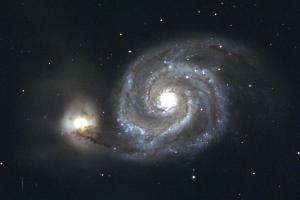What Are Spiral Arms?
What aren't spiral arms?
Spiral galaxies are beautiful things. Some of the prettiest have this grand, huge spiral arms, full of bright blue stars and ionized gas, that you can trace from the bulge out to the edge of the visible parts of the galaxy. One of the nicer examples is M51, the Whirlpool Galaxy:
There is something surprising and non-intuitive about these spiral arms, however. Consider the following: we have measured the "rotation curves" of a lot of galaxies. This is the speed that the stars and gas are moving, as a function of distance from the center of the galaxy. What we have found is that once you get only a little ways away from the center of the galaxy, that spped is approximately constant. The stars 1/3 of the way out are moving at about the same speed as the stars 2/3 of the way out on the disk of the galaxy you see in the image above. However, since the ones 2/3 of the way out have twice as far to go (since they're moving on a circle with twice the circumference), they take twice as long to make one circuit around the galaxy.
It's tempting to think of spiral arms as "material arms" – that is, a star is either "in" the spiral arm or "in between" spiral arms, and if it is in an arm, it stays in. The arm is defined by the stars in that arm, and as those stars go around, the arm goes around with it. However, this isn't right – if you think of spiral arms this way, then it's unlikely we'd see so many spiral galaxies with big, beautiful, open arms like this one here. To understand that, play with this Java applet below. (You need to have a browser that supports Java 1.4; you can get a plugin from Sun for your browser to do this.)
The bottom panel lets you set the rotation curve for the galaxy – speed (not angular speed) as a function of distance from the center of the galaxy. You can drag the points around to make whatever curve you want, but there are four pre-sets. "Milky Way" is roughly the rotation curve of our galaxy. "Keplerian" is the rotation curve of something like Solar System, where the vast majority of the mass is right at the center. "Linear" is a rigid-body rotator, like a CD or frisbee rotating around its center. "Invert" takes whatever you have and turns it upside down, so that you can see what happens if you rotate things in the other direction. Press "Start" to start the galaxy turning, and "Stop" to stop it. "Reset" resets your galaxy to its intial state.
Notice that when you use the Milky Way rotation curve, the spiral arms wrap up. They wrap up quickly – less than one full rotation of the outer parts of the galaxy. For the typical sizes of galaxies and speeds of rotation, this corresponds to no more than a few hundred million years. While that sounds like a long time, it's only a few percent of the age of the Universe. What that means is that if spiral arms were material arms, all of the spiral galaxies we see should have had plenty of time to become tightly wound. Since we see lots of galaxies like M51, this means: spiral arms can't be material arms.
OK, OK, so what are spiral arms?
Short answer: density waves. At least, in the case of these big "grand-design" spirals, that's what we think they are. So what's a density wave? It's like a sound wave. Or, it's like a traffic jam on the freeway.
Consider looking down on a freeway from above. At a bottleneck, or a busy junction, you'd see a clump of cars all bunched up together, with a higher "car density" than you would on a free-flowing straightaway. However, it isn't always the *same* cars in the junction. Cars are leaving the front of the junction and moving into the lower-density free-flowing straightaway all the time, and other cars are coming into the back of the junction and joining the bunched-up density enhancement all the time. Spiral density waves in galaxies are much like this; stars come in the back of the spiral density waves, and then move out the front. However, the stars and gas clump together while they're moving through the arms. This is why the arms are brighter – not only are there more stars, but the density enhancement of the gas triggers the formation of new stars, including very bright, blue, hot, short-lived stars. They've died out by the time they get in between the arms, so while there are more stars than you'd think in between the arms, the hottest and brightest stars tend to live out their lives while they're still in an arm.
A challenge to the model
Coming soon
Source Code
Coming soon – I'll GPL the source to this applet. In the mean time, feel free to download the Java JAR archive from this page and use it on your own page however you like.


